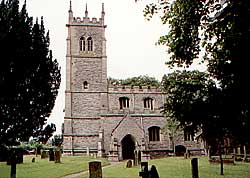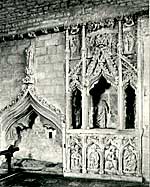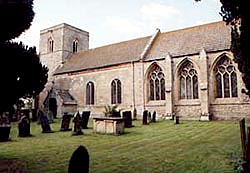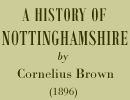< Previous | Contents | Next >
Hawton, Thorpe, Cotham, and Sibthorpe

All Saints church, Hawton. The tower dates from 1482; the chancel was built by Sir Robert de Compton in the 1330s (A. Nicholson, 2001).
HAWTON is a pleasant little village two miles from Newark, and here stood once upon a time the residence of a branch of the Molyneux family, the progenitors of the Earls of Sefton. The site of the house can still be identified, though the dimensions of it and the date of its demolition are nowhere recorded. It was erected by Thomas Molyneux, who was made a banneret at Berwick in 1482,* and here was doubtless born his more famous son, Sir Edward Molyneux, who occupied a seat on the judicial bench in the reign of Henry VII. In the church, which owed its fine tower to the Christian zeal of Sir Thomas, several members of the family lie buried, and in Thoroton’s time there were brasses to Robert Molyneux (A.D. 1539), and Dorothy his wife; and to William Molyneux (1541), and Margaret his wife; while the windows contained armorial bearings of the Molyneux, Leeke, Bussy, Bingham, FitzWilliams, Aslacton, and other ancient houses.
The principal objects of interest to be seen to-day are in the chancel, and comprise the founder’s tomb, with the effigy of one of the Comptons (descended from the Comptons of Fenny Compton, county Warwick, who once held the manor), and an Easter sepulchre, which is noted as one of the finest specimens of sculpture of its kind to be found anywhere. In architectural books the sepulchre is often referred to as superior even to that at Heckington, and one’s only regret on looking at such beautiful handiwork is that the heads of many of the figures have been sadly battered and damaged—an act of vandalism which is usually set down to the credit or discredit of iconoclasts of the seventeenth century.
Judge Molyneux settled at Thorpe, two miles away, where he would have a dwelling suitable to his position, and was succeeded there by his son, grandson, and great-grandson, the latter of whom, Sir John Molyneux, sold the manor to John Halsey and others.

The early 14th century Easter Sepulchre in Hawton Church.
At Cotham, a mile away, there was another house of universal interest and dignity, which was probably the largest mansion hereabouts in early days. Standing on the elevated position which the Hall occupied, and which is now known as the Parks, we may look across the fair plain to the village of Stoke, or, turning a little to the left, have a beautiful view of the vale of Belvoir. In the field immediately in front are some ponds, still known as the Fish-ponds, and an old resident informed us that when digging on the site of the house some years since, stones which formed part of the old foundations were turned up in considerable quantities.
In the early part of the present century there were several fine old thorns and oaks, ‘so large as to have been hollowed out for the purpose of concealment in shooting deer,’ and this is confirmatory of a statement which an aged villager recently made, that ‘there must have been many deer in the parks, for antlers had been dug out in clearing the river,’ meaning by the river the Devon, which runs at the foot of the field in which the old Hall stood.
When the Wars of the Roses were devastating the land, the Manor of Cotham was in the possession of Sir Robert Markham, to whom it had come by marriage. Sir Robert was a descendant of the Markhams of East Markham, near Tuxford; and his wife, who brought him the Manor of Cotham, was the daughter and heir of Sir Giles Daubney and of Mary, his wife, daughter of Sir Simon Leeke. ‘The family of Markham,’ says Thoroton, ‘then made Cotham their principal residence, and were of great note.’
As a wearer of the white rose, Sir Robert took an active part in support of Edward IV., and it was after the decisive Battle of Towton Field, when the crown sat safely on Edward’s royal brow, that he was created a Knight of the Bath as a reward for his loyal services. He had two sons, John and Robert, the elder of whom married Elizabeth, daughter of Sir William de Mering, and was commemorated in the Markham chantry chapel, in the choir of Newark Church, by a monument (long since disappeared) and a Latin inscription.
The eldest son, Sir John, who inherited Cotham, is mentioned by Polydore Virgil as one of the leaders at the Battle of East Stoke, an engagement that might have been watched from the windows of Cotham Hall.
Dugdale tells a funny story of Sir John. ‘He was,’ says the author, ‘an unruly spirited man, and striving with the people of Long Benington about the boundaries of their lordship, he killed some of them (some have it that he hanged the priest), for which, retiring, he lay hid at a place called Cressi Hall, which he had through his great-grandmother, the daughter of Sir John Cressi, of Hodsac. Here it was his good-fortune to entertain the Lady Margaret, mother of Henry VII., who not only procured his pardon, but married her kinswoman, Anne, to his son, who was likewise a Sir John.’
We have not met with any confirmation of this curious anecdote, but the Lady Margaret and Archbishop Cranmer were both well disposed towards Markham’s son, who died at a ripe old age in 1564, and his eldest son being dead, bequeathed to his grandson Robert ‘such implements at Cottom as can be proved heirlooms and no further,’ and the parsonage of Cotham, with the lease of Balderton Grange.
Robert Markham, who came to Cotham after his grandfather, was born at Syerston, where his father had a house. Robert was more often seen at Court than on his estates, being a favourite with Queen Elizabeth, who described him in a couplet as ‘Markham the Lion.’ One of his sons was an author, and a very voluminous writer. Plays, poems, and numerous treatises on horsemanship, farming, farriery, sports and pastimes, heraldry and military discipline, emanated from his fertile pen.
The eldest of the brothers, who bore his father’s name of Robert, remains to be mentioned. He came into possession of the Cotham property, but was, as Thoroton describes him, ‘a fatal unthrift and destroyer of this eminent family.’ He was a courtier, as his father had been before him, and when Queen Elizabeth visited Sir Robert Sydney, he did several gallant feats on a horse before the gate, leaping down and kissing his sword, then mounting swiftly on his saddle, and passing a lance with much skill. In his hands the family funds dwindled and were dispersed, Cotham passed by sale from the Markhams, and with the demolition of the Hall the village bade a long farewell to all its greatness as the abode of a powerful and historic family.
 St Peter, Sibthorpe, has a 13th century
tower, 18th century nave and a 14th century chancel (built in connection
with the foundation of a college of priests in 1335. (A. Nicholson,
2000).
St Peter, Sibthorpe, has a 13th century
tower, 18th century nave and a 14th century chancel (built in connection
with the foundation of a college of priests in 1335. (A. Nicholson,
2000).Not far from the site once occupied by the Hall is the church, a small, unpretentious structure; Inside is a tomb to one of the Markhams, and a handsome monument, bearing upon it the figures of a lady and seven children, and the following inscription: ‘Ann, Dr of John Warburton of Cheshire, Knight, wife to Robert Markham, of Cotham, Esquire, died ye 17 Nov., 1601.’ Another substantial house close by was at Sibthorpe, where also stood a college, founded by Thomas de Sibthorpe, parson of Beckingham, who was a great man in his day (temp. Edward II.). The house is described as ‘a large mansion,’ and it stood in a field near the church. It belonged to the Burnell family, to one of whom, Edward Burnell, who died in 1589, there is a fine alabaster monument in the chancel of the church, erected by his widow. The position of the college is not so easy to define as that of the mansion and park, though, judging from the conformation of the ground, a very probable site can be pointed out in one of the fields. We have some evidence of the dimensions of the building in a letter written by Thomas Magnus, who was warden of the college in the reign of Henry VIII., to Cardinal Wolsey. The college was surrendered to the King April 17, 37th Henry VIII., and, with all its lands, granted to Thomas Magnus and Richard Whalley. Magnus had only a life interest in it, so that at his demise it became the private property of the Whalley family. Dr. Thomas Secker, who became Archbishop of Canterbury in 1758. was born at Sibthorpe in 1693, and in the little church of Shelton is a tablet to the memory of his father.
